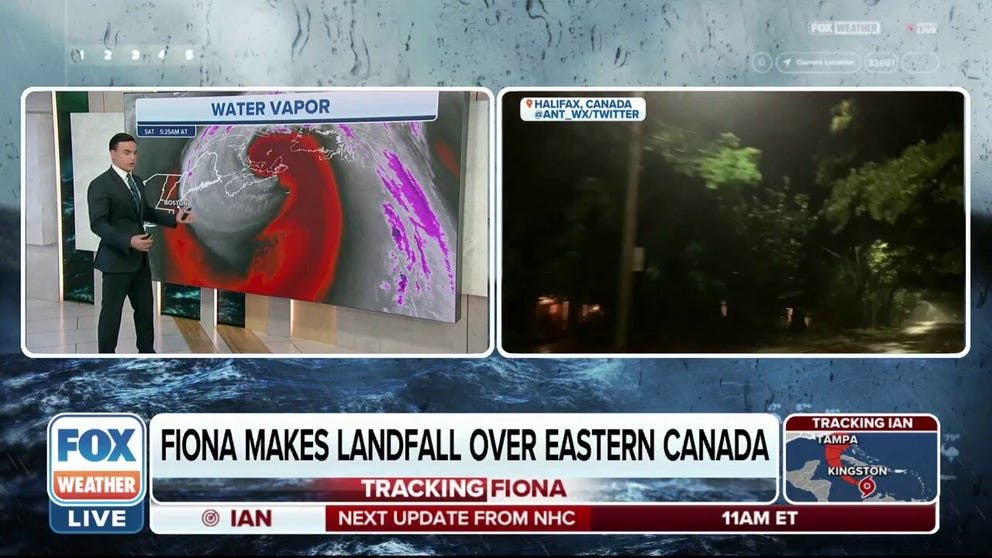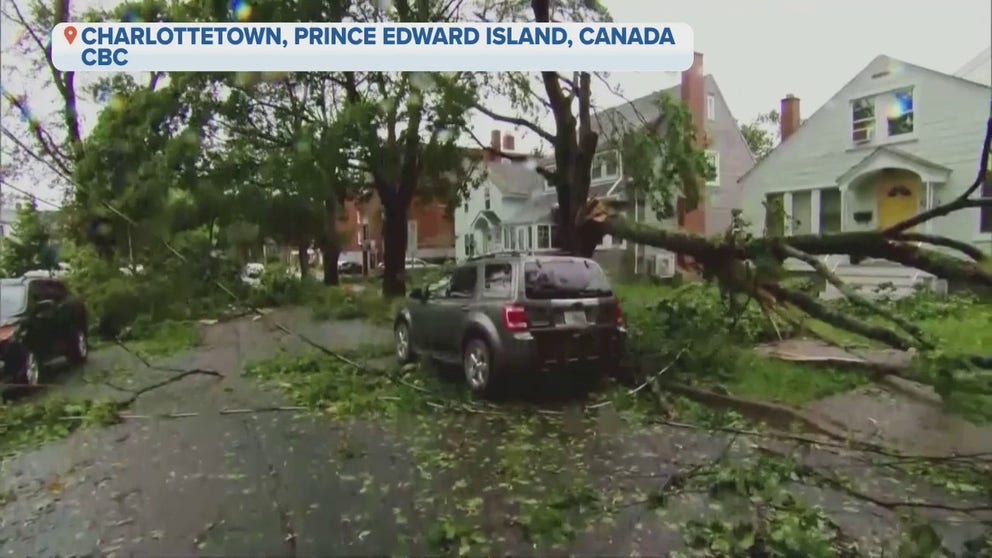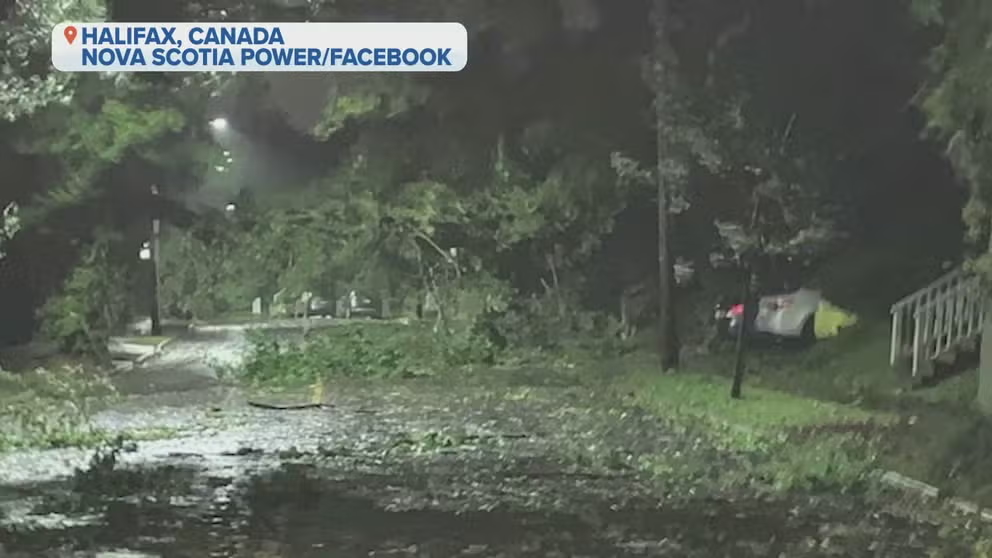Ferocious Fiona leaves behind trail of destruction from Caribbean to Canadian Maritimes
Widespread, potentially prolonged power outages, numerous downed trees, structural damage, washed-out roads and significant coastal erosion due to battering waves and storm surge are all potential impacts of Fiona in Atlantic Canada.
Fiona makes landfall over eastern Canada
Fiona transitioned into a post-tropical cyclone Friday evening as it slammed into the Canadian Maritimes with hurricane-force winds, torrential rainfall and significant storm surge.
Fiona transitioned into a powerful post-tropical cyclone Friday evening as it slammed into the Canadian Maritimes with hurricane-force winds and a pressure that the Canadian Hurricane Centre said was lowest of any landfalling system in the country's history.
Thousands of miles of coastline from New Brunswick to Newfoundland were under tropical cyclones alerts as winds gusted to over 100 mph and an unofficial pressure was reported of 931.6 millibars.
The winds damaged trees and powerlines and sent a tremendous storm surge into the Canadian Maritimes which damaged boats and flooded homes.
HOW TO WATCH FOX WEATHER ON TV
Fiona left behind a trail of destruction in Canada
The former hurricane was the strongest land falling storm on record in eastern Canada knocking down trees, damaging homes and leaving thousands without power.
Fiona's trek of terror lasted for more than 10 days from near the Caribbean islands, where the cyclone first became a tropical depression, to the waters of the North Atlantic where the system became a powerful post-tropical cyclone.
During its journey Fiona was the strongest cyclone of the 2022 Atlantic hurricane season and at one point was a Category 4 with sustained winds around 130 mph.
Its destructive winds and torrential rainfall were blamed for causing the deaths of at least a dozen people and plunged the entire island of Puerto Rico into darkness.
Post-Tropical Cyclone Fiona impacts to Canada
Despite the large storm system moving over cold water, the cyclone was able to take advantage of the clash of air masses and produce destruction similar to hurricanes.
Wind gusts were reported higher than 100 mph which led to widespread damage from Nova Scotia to Newfoundland.
Fiona impacts eastern Canada
Fiona made landfall Saturday in eastern Canada
So far, the country has not reported deaths associated with the storm, but damage assessments of Saturday were in their early stages.
"Fiona is the most significant rain and wind event Nova Scotia has seen in close to 20 years. Thousands of people are on the ground working hard to assess damage and restore power, but they need some help," John Lohr, minister responsible for the Emergency Management Office, said in a statement. "Through past experiences with storms like Dorian, we know the military makes a real difference in how quickly we can get trees cut and removed, debris cleared and power restored."
At the height of the storm, more than 500,000 people were reported to be without power in Canada's eastern provinces.
The region is no stranger to hurricanes or their remnants.
Since 1951, the Canadian Hurricane Centre said the country has seen around two-dozen hurricanes or post-tropical cyclones that have made landfall along its Atlantic coast.
The names of recent tropical cyclones to impact the expansive coastline include Larry in 2021 and both Teddy and Isaias in 2020.
Hurricane Juan of 2003 is considered to be the most destructive in recent history. The Category 2 hurricane made landfall with winds of around 100 mph on Sept. 29.
HURRICANE FIONA'S PATH TO CANADA IS NOT COUNTRY'S FIRST HURRICANE IMPACT
Major Hurricane Fiona impacts to Bermuda
Hurricane Fiona's closest approach to Bermuda was over 100 miles away, but that did not prevent the entire British territory from seeing significant impacts from the major storm.
FOX Weather's Robert Ray experienced the worst of what the storm brought to the island.
Wind gusts to 93 mph caused the majority of the island to temporarily lose power.
The island was spared from the core of the storm with many weather stations reporting sustained winds below the threshold of a Category 1 hurricane.
DRONE VIDEO SHOWS 50-FOOT WAVES AND DESTRUCTIVE WINDS IN THE HEART OF HURRICANE FIONA
Hurricane Fiona's impacts on the U.S.
Even though Fiona stayed several hundreds miles off the U.S. East Coast, indirect effects in the form of high seas and rough surf impacted beaches from Florida through Maine,
The rough seas caused life-threatening rip currents along beaches, and lifeguards cautioned less-skilled swimmers to stay out of the waters.
The increased surf was enough to send overwash onto North Carolina Highway 12, the main thoroughfare that links the mainland to the Outer Banks.
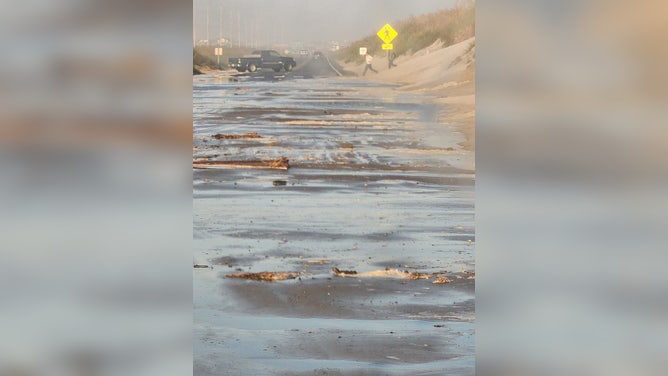
NCDOT reports overwash just north of Hatteras Village and on the north side of Ocracoke.
(NCDOT)
The North Carolina Department of Transportation said they reinforced dunes before the arrival of the storm's waves to minimize travel interruptions.
Despite a wide area impacted by rough seas and rip currents, there were no reported deaths along the East Coast.
WATER FROM HURRICANES, TROPICAL STORMS KILLS MORE IN U.S. THAN WIND
Hurricane Fiona's impacts in the Caribbean
Fiona made two landfalls as a Category 1 hurricane, the first one Sunday afternoon along the extreme southwestern coast of Puerto Rico and the second one early Monday morning in the eastern Dominican Republic.
In Puerto Rico, the city of Ponce clocked a 103-mph wind gust, while in the Dominican Republic, a gust of 98 mph was recorded in Samana at El Catey International Airport. The high winds plunged all of Puerto Rico into a blackout on Sunday as catastrophic flooding unfolded across the U.S. territory.
DEATH TOLL RISES TO AT LEAST 8 AFTER POWERFUL HURRICANE FIONA LASHES CARIBBEAN
On Wednesday, President Joe Biden declared Puerto Rico a major disaster area to help with recovery efforts.
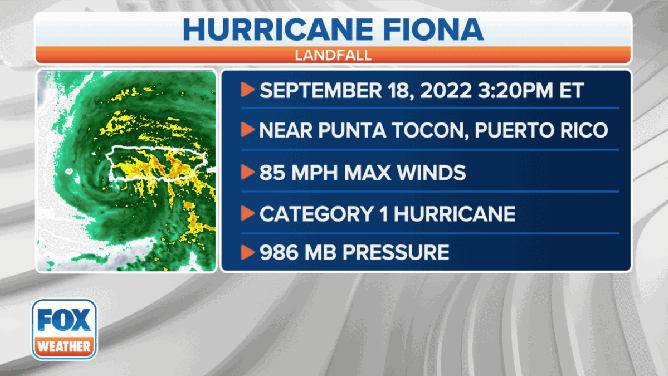
Hurricane Fiona made its first landfall in southwestern Puerto Rico on Sunday, Sept. 18, followed by a second landfall in the eastern Dominican Republic on Monday, Sept. 19.
(FOX Weather)
FEROCIOUS HURRICANE FIONA BATTERS TURKS AND CAICOS ISLANDS WITH STRONG WINDS, TORRENTIAL RAIN
Hurricane Fiona battered the Turks and Caicos on Tuesday as high winds and heavy rain spread across the islands after the hurricane had already turned deadly in Puerto Rico and the Dominican Republic.
